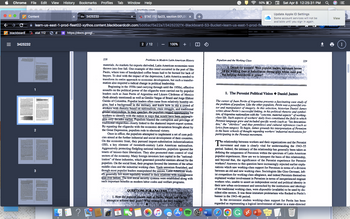Question
- How did workers use populist leaders to improve their position in society and how did populist leaders use workers to stay in power?
Consult the PDF reading titled “Populism and the Working Class,” pp. 227-249

Transcribed Image Text:✔ Chrome File Edit View History Bookmarks Profiles Tab Window Help
OOO
← → C
blackboard
Content
= 3425232
STAT 112
stat 112
2
XBb 3425232
STAT 112 Sp23, section 001,00 X +
learn-us-east-1-prod-fleet02-xythos.content.blackboardcdn.com/5dd6acf5e22a7/3425232?X-Blackboard-S3-Bucket-learn-us-east-1-prod-flector m
3
dhttps://docs.googl...
691
228
hartlahu.com
Problems in Modern Latin American History
materials. As markets for exports shriveled, Latin American economies were
thrown into free fall. One example of this trend occurred in the port of São
Paulo, where tons of handpicked coffee beans had to be burned for lack of
buyers. To deal with the impact of the depression, Latin America needed to
transform its entire approach to economic development, but such a transfor-
mation also required a radical change in political leadership.
2 / 12
APR
8
Beginning in the 1930s (and carrying through until the 1950s), effective
assaults on the political power of the oligarchs were carried out by populist
leaders such as Juan Perón of Argentina and Lázaro Cárdenas of Mexico
(both already mentioned) as well as Getúlio Vargas of Brazil and Jorge Eliécer
Gaitán of Colombia. Populist leaders often came from relatively humble ori-
gins, had a background in the military, and knew how to stir a crowd of
workers with rhetoric based on nationalism, class struggle, and traditional
gender relationships. In their speeches, the populists created opportunities for
workers to identify with the nation in ways that would have been unimagin-
able only decades earlier. Populists blasted the corruption and privilege of
traditional oligarchies closely linked to the shattered import-export system.
By equating the oligarchs with the economic devastation brought about by
the Great Depression, populists rode to electoral victory.
Once in office, the populists attempted to implement a set of core poli-
cies aimed at the further industrial and social development of their countries.
On the economic front, they pursued import-substitution industrialization
(ISI), a key element of twentieth-century Latin American nationalism.
Aggressively protecting fledgling national industries, populists ignored the
tenets of laissez-faire liberalism. They also promoted state control of vital
sectors of the economy. Many foreign investors lost capital in the "national-
ization" of these industries, which generated powerful enemies abroad for the
populists. On the social front, their program favored the interests of the urban
middle class and the industrial working class. Trade unionism flourished, and
though most populist leaders manipulated the unions, Latin American work-
efs generally felt more equitably treated in their relations with management
than ever before. The first social security systems were established along with
such important benefits as modern labor codes and welfare programs.
21
100% + »
QUESTIONS FOR ANALYSIS
MEANI
1. How did populist leaders such as Peron, Vargas, and than
attempt to achieve their goals? What strategies did they employ?
Leitung
A
W
50%
==
Sat Apr 8 12:25:31 PM
Update Apple ID Settings
Some account services will not be
available until you sign in again.
Populism and the Working Class
3. Decide for yourself. Were populist leaders legitimate heroes
for the working class or authoritarian demagogues whose main goal
was keeping themselves in power?
Sing
pagga
229
1. The Peronist Political Vision ◆ Daniel James
The career of Juan Perón of Argentina presents a fascinating case study of
the problem of populism. Like the other populists, Perón was a powerful ora-
tor and manipulator of imagery. In this selection, historian Daniel James
writes about Perón's successful linking, in his political rhetoric and symbol-
ism, of Argentine nationalism with the "concrete, material aspects" of working-
class life. Such aspects of workers' daily lives constituted the field in which
Peronist language grew and included specific words (such as "los descamisa-
dos," the "shirtless" and thus penniless) and cultural references (such as
lyrics from tangos). To begin, James grounds his interpretation of Peronism
in the basic schools of thought regarding workers' industrial motivations for
participating in the Peronist movement.
The relationship between workers and their organizations and the Peronist
movement and state is clearly vital for understanding the 1943-55
period. Indeed, the intimacy of the relationship has generally been taken as
defining the uniqueness of Peronism within the spectrum of Latin American
populist experiences. How are we to interpret the basis of this relationship,
and beyond that, the significance of the Peronist experience for Peronist
workers? Answers to this question have increasingly rejected earlier expla-
nations which saw working-class support for Peronism in terms of a division
between an old and new working class. Sociologists like Gino Germani, left-
ist competitors for working-class allegiance, and indeed Peronists themselves
explained worker involvement in Peronism in terms of inexperienced migrant
workers who, unable to assert an independent social and political identity in
their new urban environment and untouched by the institutions and ideology
of the traditional working class, were disponible (available) to be used by dis-
sident elite sectors. It was these immature proletarians who flocked to Perón's
banner in the 1943-46 period.
In the revisionist studies working-class support for Perón has been
regarded as representing a logical involvement of labor in a state-directed
GP
PA
Q
View
Expert Solution
This question has been solved!
Explore an expertly crafted, step-by-step solution for a thorough understanding of key concepts.
This is a popular solution
Trending nowThis is a popular solution!
Step by stepSolved in 3 steps
